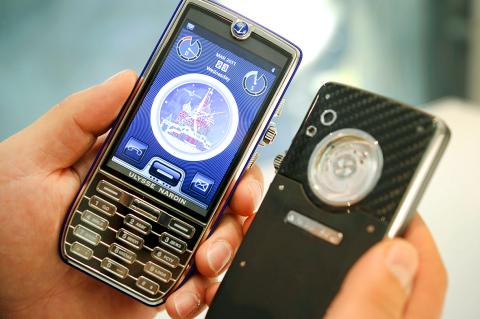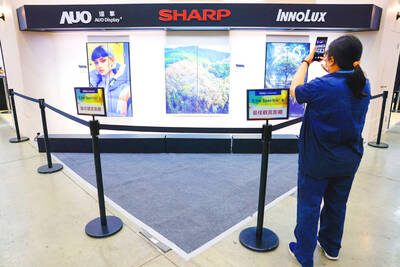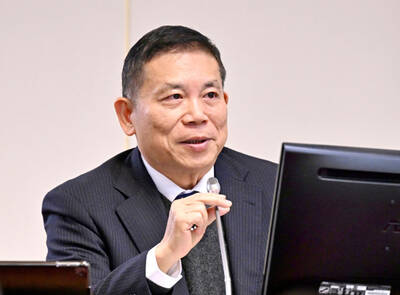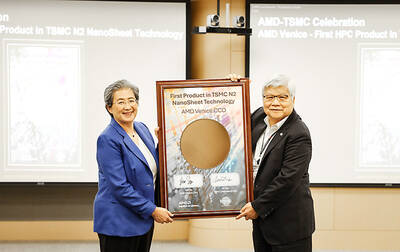With the younger generation opting to use their smartphones to tell time, the watch-making industry is being forced to get smart and high-tech to recapture consumers.
On show at the industry’s biggest watch and jewelery fair Baselworld this year are not only diamond-encrusted mechanical watches with complex movements, but an increasing number of timepieces that combine with the smartphone.
Some watchmakers unveiled luxury phones that incorporate mechanical watches, others were featuring watches with touchscreens. Japanese digital watchmaker Casio premiered watches that are able to communicate with smartphones.

Photo: AFP
“Many young people don’t wear watches anymore these days. They use their mobile phones to tell time,” said Fabrice Gonet, a designer from Slyde Watch SA.
Gonet and his business partners decided to create an electronic wristwatch with a touchscreen, which “lets people download photos, personalize their watch face,” although it does not have the telephone function.
“We thought of making this watch to recreate the link between horlogery and young people,” he said.
Asked if Apple could be a potential competitor, Gonet said that his company has taken out a patent for a virtual mechanic movement.
“The first thing we did was a feasibility study and we found that there was no patents for this. It was surprising, but it convinced us to go into it,” he added.
His company is not the only one tapping the smartphone market.
Ulysse Nardin, a Swiss luxury watchmaker, launched what it claimed is “the world’s first luxury hybrid smartphone,” integrating a mechanical watch rotor into the mobile phone.
The automatic rotor also creates energy to provide additional power to the phone.
Bobby Yampolsky, co-founder of UN Cells, who make the phones for Ulysse Nardin, admitted that it is insufficient to act as the sole power supply for the phone.
“If you wind it for four, five minutes you can make about a 30 second phone call or a few texts,” Yampolsky said.
Nevertheless, Yampolsky believes that such hybrid phones are the way forward.
“I feel this is the future. The watch world is over 300 years old. Cellphones are 30 years old. Before cellphones, watches were mobile technology. This is now mobile technology,” he said, holding up the phone, each of which costs between US$12,800 and US$130,000.
Mobile phones are “never going to take over completely, but it’s going to take up a huge part of the marketplace,” he added.
“The philosophy for us when we made this phone is, we asked ourselves, what do men have as a status symbol? We have our watches and we have our cars. This is basically the Ferrari that you can bring into a restaurant and put on the dining table,” Yampolsky said.
However, Casio, a long-term player in the watch industry that championed the quartz technology which almost brought about the demise of the mechanical watch, believes that there is still a place for the wristwatch.
This year, it introduced a watch that communicates with the mobile phone.
Casio’s managing director Hiroshi Nakamura explained that if the mobile phone rings during a meeting, a tap of the watch would stop the ringing.
Likewise, an e-mail arriving on a smartphone would also prompt a message on the wristwatch that a piece of mail has been received.
“You don’t always keep a mobile phone in your hands, you’ll put it in your bag. So it’s easier when you’re receiving a call to just tap on the watch,” Nakamura said.
“We don’t think that the iPhone will take the place of a watch. We see more possibilities for the watch,” he added.
“If you have a bluetooth watch and a smartphone then you don’t have to adjust the time when you’re traveling,” he said.
Casio’s latest watch will be available by the end of the year, with a launch due in the domestic market before broadening to other markets.

UNCERTAINTY: Innolux activated a stringent supply chain management mechanism, as it did during the COVID-19 pandemic, to ensure optimal inventory levels for customers Flat-panel display makers AUO Corp (友達) and Innolux Corp (群創) yesterday said that about 12 to 20 percent of their display business is at risk of potential US tariffs and that they would relocate production or shipment destinations to mitigate the levies’ effects. US tariffs would have a direct impact of US$200 million on AUO’s revenue, company chairman Paul Peng (彭雙浪) told reporters on the sidelines of the Touch Taiwan trade show in Taipei yesterday. That would make up about 12 percent of the company’s overall revenue. To cope with the tariff uncertainty, AUO plans to allocate its production to manufacturing facilities in

TAKING STOCK: A Taiwanese cookware firm in Vietnam urged customers to assess inventory or place orders early so shipments can reach the US while tariffs are paused Taiwanese businesses in Vietnam are exploring alternatives after the White House imposed a 46 percent import duty on Vietnamese goods, following US President Donald Trump’s announcement of “reciprocal” tariffs on the US’ trading partners. Lo Shih-liang (羅世良), chairman of Brico Industry Co (裕茂工業), a Taiwanese company that manufactures cast iron cookware and stove components in Vietnam, said that more than 40 percent of his business was tied to the US market, describing the constant US policy shifts as an emotional roller coaster. “I work during the day and stay up all night watching the news. I’ve been following US news until 3am

Taiwan will prioritize the development of silicon photonics by taking advantage of its strength in the semiconductor industry to build another shield to protect the local economy, National Development Council (NDC) Minister Paul Liu (劉鏡清) said yesterday. Speaking at a meeting of the legislature’s Economics Committee, Liu said Taiwan already has the artificial intelligence (AI) industry as a shield, after the semiconductor industry, to safeguard the country, and is looking at new unique fields to build more economic shields. While Taiwan will further strengthen its existing shields, over the longer term, the country is determined to focus on such potential segments as

COLLABORATION: Given Taiwan’s key position in global supply chains, the US firm is discussing strategies with local partners and clients to deal with global uncertainties Advanced Micro Devices Inc (AMD) yesterday said it is meeting with local ecosystem partners, including Taiwan Semiconductor Manufacturing Co (TSMC, 台積電), to discuss strategies, including long-term manufacturing, to navigate uncertainties such as US tariffs, as Taiwan occupies an important position in global supply chains. AMD chief executive officer Lisa Su (蘇姿丰) told reporters that Taiwan is an important part of the chip designer’s ecosystem and she is discussing with partners and customers in Taiwan to forge strong collaborations on different areas during this critical period. AMD has just become the first artificial-intelligence (AI) server chip customer of TSMC to utilize its advanced